
The Central Pacific Railroad (CPRR) was a rail company chartered by U.S. Congress in 1862 to build a railroad eastwards from Sacramento, California, to complete the western part of the "First transcontinental railroad" in North America. Incorporated in 1861, CPRR ceased operation in 1959 when assets were formally merged into the Southern Pacific Railroad.

America's first transcontinental railroad was a 1,911-mile (3,075 km) continuous railroad line constructed between 1863 and 1869 that connected the existing eastern U.S. rail network at Council Bluffs, Iowa, with the Pacific coast at the Oakland Long Wharf on San Francisco Bay. The rail line was built by three private companies over public lands provided by extensive US land grants. Building was financed by both state and US government subsidy bonds as well as by company-issued mortgage bonds. The Western Pacific Railroad Company built 132 miles (212 km) of track from the road's western terminus at Alameda/Oakland to Sacramento, California. The Central Pacific Railroad Company of California (CPRR) constructed 690 miles (1,110 km) east from Sacramento to Promontory Summit, Utah Territory. The Union Pacific Railroad (UPRR) built 1,085 miles (1,746 km) from the road's eastern terminus at the Missouri River settlements of Council Bluffs and Omaha, Nebraska, westward to Promontory Summit.

Box Elder County is a county at the northwestern corner of Utah, United States. At the 2020 census, the population was 57,666, up from the 2010 figure of 49,975. Its county seat and largest city is Brigham City. The county was named for the box elder trees that abound in the county.

Brigham City is a city in Box Elder County, Utah, United States. The population was 19,650 at the 2020 census, up from the 2010 figure of 17,899. It is the county seat of Box Elder County. It lies on the western slope of the Wellsville Mountains, a branch of the Wasatch Range at the western terminus of Box Elder Canyon. Brigham City saw most of its growth during the 1950s and 1960s but has seen a struggling economy and stagnating growth. It is near the former headquarters of ATK Thiokol, now Northrop Grumman, the company that created the solid rocket boosters for the Space Shuttle.

Corinne is a city in Box Elder County, Utah, United States. The population was 809 at the 2020 census, up from the 2010 figure of 685.
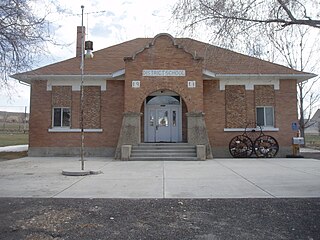
Howell is a town located in the Blue Creek Valley in northeast Box Elder County, Utah, United States. The population was 245 at the 2010 census.

Promontory is an area of high ground in Box Elder County, Utah, United States, 32 mi (51 km) west of Brigham City and 66 mi (106 km) northwest of Salt Lake City. Rising to an elevation of 4,902 feet (1,494 m) above sea level, it lies to the north of the Promontory Mountains and the Great Salt Lake. It is notable as the location of Promontory Summit, where the First transcontinental railroad from Sacramento to Omaha in the United States was officially completed on May 10, 1869. The location is sometimes confused with Promontory Point, a location further south along the southern tip of the Promontory Mountains. Both locations are significant to the Overland Route; Promontory Summit is where the original, abandoned alignment crossed the Promontory Mountains while the modern alignment, called the Lucin Cutoff, crosses the mountains at Promontory Point.
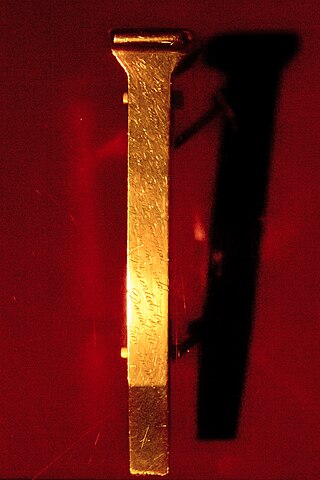

Golden Spike National Historical Park is a United States National Historical Park located at Promontory Summit, north of the Great Salt Lake in east-central Box Elder County, Utah, United States. The nearest city is Corinne, approximately 23 miles (37 km) east-southeast of the site.
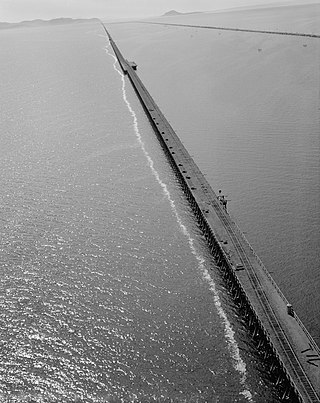
The Lucin Cutoff is a 102-mile (164 km) railroad line in Utah, United States that runs from Ogden to its namesake in Lucin. The most prominent feature of the cutoff was a twelve-mile-long (19 km) railroad trestle crossing the Great Salt Lake, which was in use from 1904 until the late 1950s, when it was replaced by an earthen causeway.

The Niles Canyon Railway (NCRy) is a heritage railway running on the first transcontinental railroad alignment through Niles Canyon, between Sunol and the Niles district of Fremont in the East Bay of the San Francisco Bay Area, in California, United States. The railway is listed on the National Register of Historic Places as the Niles Canyon Transcontinental Railroad Historic District. The railroad is operated and maintained by the Pacific Locomotive Association which preserves, restores and operates historic railroad equipment. The NCRy features public excursions with both steam and diesel locomotives along a well-preserved portion of the first transcontinental railroad.
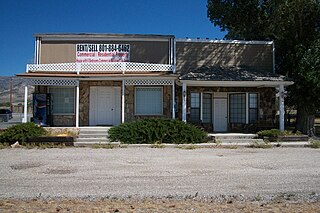
Park Valley is an unincorporated community in north-central Box Elder County, Utah, United States.
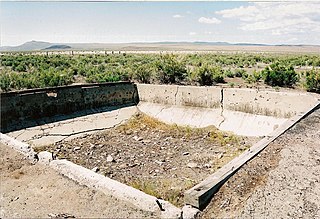
Kelton is a ghost town, just north of the Great Salt Lake, in the Park Valley area of Box Elder County, Utah, United States. The town was inhabited during the period of 1869–1942. Once an important section station on the First transcontinental railroad, Kelton was dependent on the railroad throughout its history. The town suffered serious setbacks in the 1880s when its busy stagecoach route to Boise, Idaho was discontinued, and in the 1900s when the Lucin Cutoff left it off the main rail line. The strongest earthquake in Utah history caused severe damage in 1934, but Kelton ceased to exist only when the rails were completely removed during World War II.

Terrace is a ghost town in the Great Salt Lake Desert in west-central Box Elder County, Utah, United States.

The Big Fill was an engineering project on the first transcontinental railroad in the U.S. state of Utah. To avoid a costly 800-foot (240 m) tunnel through mountainous terrain east of Promontory Summit, Central Pacific engineers mapped an alternate route that still needed to span the deep Spring Creek Ravine.
Russian Settlement is a ghost town in the Park Valley area of Box Elder County, Utah, United States. It is not known what name, if any, the settlers from Russia gave to their community; it has been called "Box Elder County's ghost town with no name." The settlement, which lasted from about 1914–1917, was formed by a group of Molokan Spiritual Christians from Russia of mixed faiths and ethnicities. The colony failed quickly because the company who sold them the land exaggerated its quality and never provided promised facilities to make the land livable. The most noticeable remnant of Russian Settlement is a cemetery with two graves.
Promontory Point is a ghost town in Box Elder County, Utah, United States, that is located about 1.7 miles (2.7 km) northeast of the cape with the same name.

The Transcontinental Railroad Grade is a section of railway in northwest Utah, near Corinne, Utah, which was listed on the National Register of Historic Places in 1994.
Kosmo is a ghost town in Box Elder County, Utah, United States. The town was built in two sections, with the east end built in 1901 to serve as a rail spur of the First transcontinental railroad for the ranchers in the area.
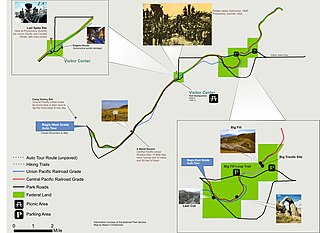
The tracklaying race of 1869 was an unofficial contest between tracklaying crews of the Union Pacific and Central Pacific railroads, held during the construction of the first transcontinental railroad. The competition was to determine who would first reach the meeting place at Promontory, Utah. Starting in 1868, the railroad crews set, and subsequently broke, each other's world records for the longest length of track laid in a single day. This culminated in the April 28, 1869, record set by Chinese and Irish crews of the Central Pacific who laid 10 miles 56 feet (16.111 km) of track in one day. That record was broken in August 1870, by about 1,000 feet (300 m), by two crews of the Kansas Pacific, working from opposite ends of the same track.




















